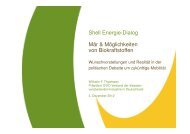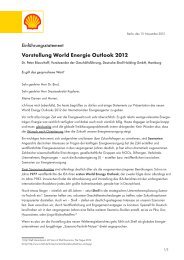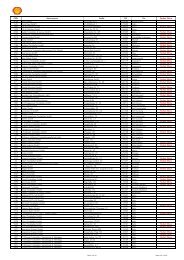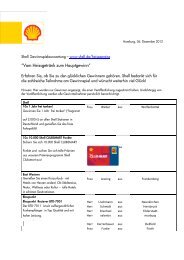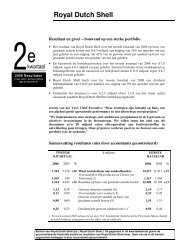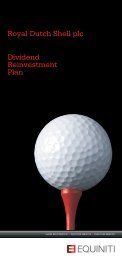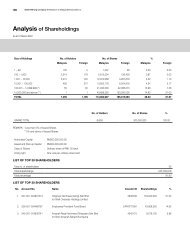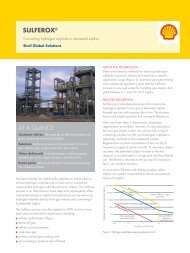ENVIRONMENTAL STATEMENT BARDOLINO DEVELOPMENT
ENVIRONMENTAL STATEMENT BARDOLINO DEVELOPMENT
ENVIRONMENTAL STATEMENT BARDOLINO DEVELOPMENT
Create successful ePaper yourself
Turn your PDF publications into a flip-book with our unique Google optimized e-Paper software.
Bardolino Development Environmental Statement<br />
the noise resulting from the pipeline installation would have any measurable or long-term<br />
effect on marine mammals frequenting the area.<br />
Inspection of the data in Table 6.6, and assessment of the range of noise sources, and their<br />
magnitude and duration, indicates that the noise from piling would be the most significant<br />
potential source of underwater noise affecting marine mammals. Consequently the rest of<br />
this section examines this noise and its potential effects in greater detail.<br />
6.7.2 Noise produced development activities<br />
Noise generated during piling operations<br />
Piling operations create underwater noises of a frequency and level that are audible to seals,<br />
toothed and baleen whales, and fish (Richardson et al., 1995; Nedwell & Howell, 2004;<br />
Nedwell et al., 2004). Noise from piling can enter the marine environment by four pathways,<br />
the most significant of which is thought to be by transmission of vibration through the pile itself<br />
directly into the water column. The noise produced during piling is dependent on the several<br />
factors including the type of equipment used, the size of the pile, the water depth and the<br />
characteristics of the seabed (Nedwell et al., 2004).<br />
The production manifold would be secured to the seabed by means of four piles. Each pile<br />
would be 610 mm in diameter and 20 m long, and would be driven to the required depth in the<br />
seabed by an underwater vibro-hammer. It would take about 12 hours to install the four<br />
manifold piles.<br />
The valve skid would be secured to the seabed by means of four piles, and these would be of<br />
smaller diameter and length than those used to install the production manifold. Again, each<br />
pile would be installed separately using a vibro-hammer, and it would take about 12 hours to<br />
drive the 4 valve skid piles.<br />
There are no specific measurements available for the noise levels that would be produced<br />
during operations to fix such piles in a sandy clayey seabed in a water depth of approximately<br />
85 m. From noise measurements of other piling operations taken under different<br />
circumstances, however, there appears to be a correlation between the diameter of the pile<br />
being driven and the Source Noise Level (SL) (Nedwell et al., 2005). The best fit line shows;<br />
SL = 24.3D +179 dB re 1µPa @ 1 m<br />
where D is pile diameter in metres. Application of this equation would suggest that the source<br />
noise level for a 0.61 m (610 mm) diameter pile might be approximately 194 dB re 1µPa @ 1<br />
m. The frequency profile for piling noise is rather “flat” with no obvious peak, but maximum<br />
pressure levels are attained over the range 300 - 1,000 Hz (Nedwell et al., 2005). The larger<br />
piles used to secure the production manifold will produce a higher source level than those<br />
required to secure the valve skid, so modelling has been undertaken for the production<br />
manifold piling as this represents the worst case event.<br />
Acoustic propagation modelling was conducted for the production manifold pile driving at the<br />
Bardolino field, using accepted formulae, to calculate the noise propagation in the marine<br />
environment. This was combined with audiograms for marine mammals to predict the<br />
distances at which strong avoidance and a Temporary Threshold Shift (TTS) would occur in<br />
the species which are most likely to be exposed to the noise from piling. The technique<br />
employed reflects the current state of knowledge regarding underwater noise and its impact<br />
on marine species.<br />
During piling the noisiest vessel that is likely to be under way and in close proximity to the<br />
piling operations would be a DP vessel. The decibel scale used to measure sound is a<br />
logarithmic scale, therefore the presence of several sources of noise at any location at any<br />
one time leads to only a small increase in the total source level of noise at the site. The<br />
estimated noise level from this DP vessel operating at the site would be 180 dB re 1µPa dB<br />
@ 1 m. The difference between the source level noise for piling (194 dB) and source level<br />
noise for the vessel (180 dB) is more than 10 dB, so the presence of this additional noise<br />
Page 6-20 April 2008


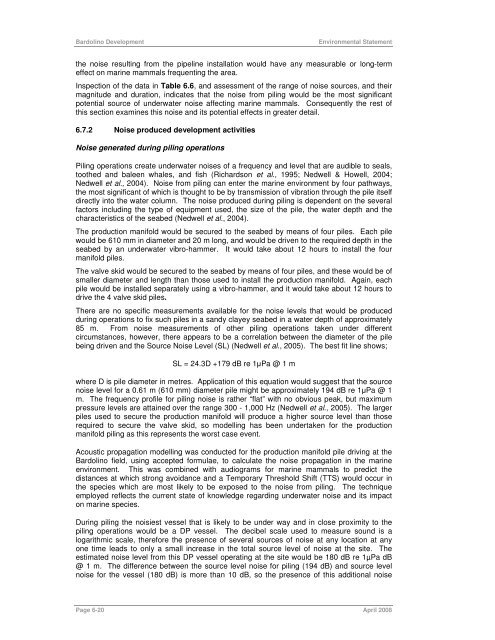

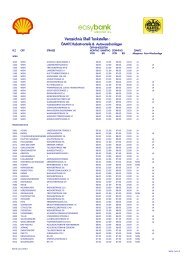
![Download Shell AutoGas Stationen [Stand: Januar 2013] (PDF](https://img.yumpu.com/9982753/1/190x245/download-shell-autogas-stationen-stand-januar-2013-pdf.jpg?quality=85)
